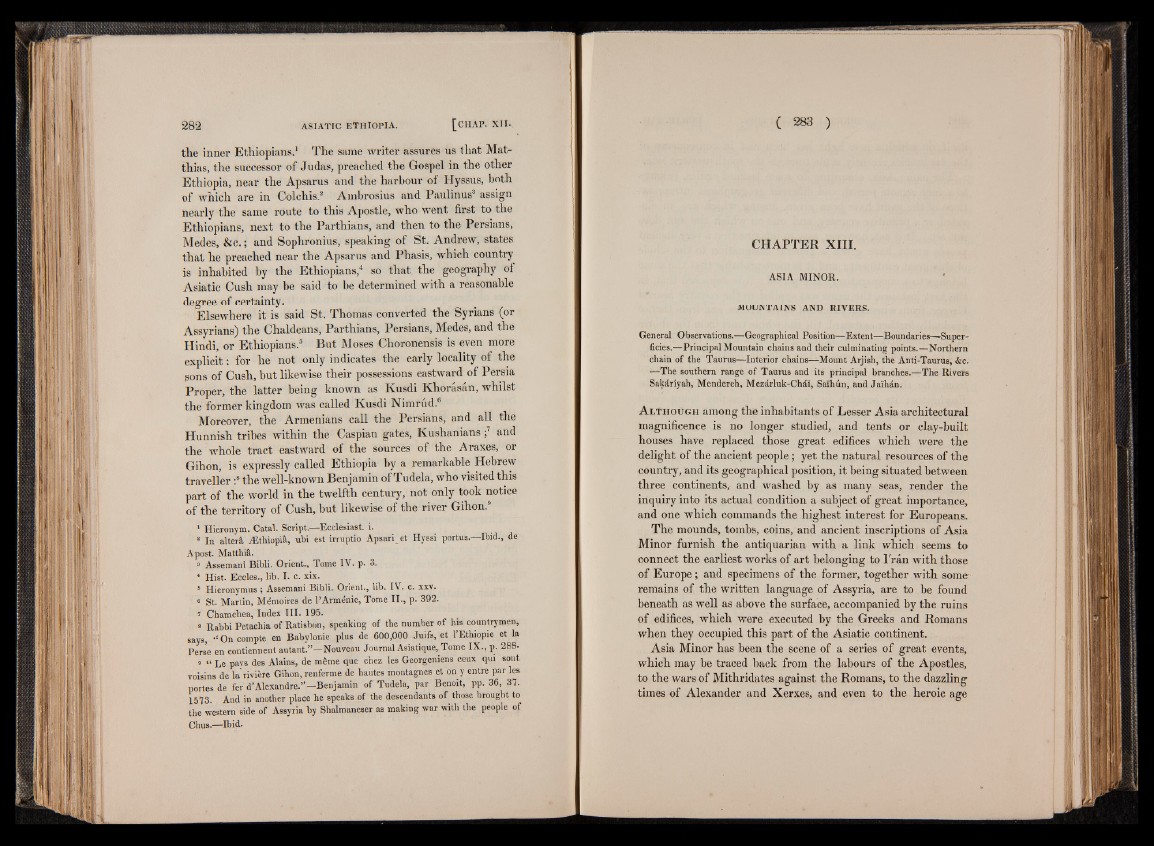
the inner Ethiopians.1 The same writer assures us that Matthias,
the successor of Judas, preached the Gospel in the other
Ethiopia, near the Apsarus and the harbour of Hyssus, both
of which are in Colchis.2 Ambrosius and Paulinus3 assign
nearly the same route to this Apostle, who went first to the
Ethiopians, next to the Parthians, and then to the Persians,
Medes, &c. ; and Sophronius, speaking of St. Andrew, states
that he preached near the Apsarus and Phasis, which country
is inhabited by the Ethiopians,4 so that the geography of
Asiatic Cush may be said to be determined with a reasonable
degree of certainty.
Elsewhere it is said St. Thomas converted the Syrians (or
Assyrians) the Chaldeans, Parthians, Persians, Medes, and the
Hindi, or Ethiopians.5 But Moses Choronensis is even more
explicit : for he not only indicates the early locality of the
gons of Cush, but likewise their possessions eastward of Persia
Proper, the latter being known as Kusdi Khorâsân, whilst
the former kingdom was called Kusdi Nimrud.6
Moreover, the Armenians call the Persians, and all the
Hunnish tribes within the Caspian gates, Kushanians ;7 and
the whole tract eastward of the sources of the A raxes, or
Gihon, is expressly called Ethiopia by a remarkable Hebrew
traveller :8 the well-known Benjamin of Tudela, who visited this
part of the world in the twelfth century, not only took notice
of the territory of Cush, but likewise of the river Gihon.9
1 Hieronym. Catal. Script.-—Ecclesiast. i.
! ln alterâ Æthiupià, ubi est irruptio Apsari et Hyssi portus.—Ibid., de
A post. Matthiâ.
3 Assemani Bibli. Orient., Tome IY. p. 3.
4 Hist. Eccles., lib. I. c. xix.
8 Hieronymus ; Assemani Bibli. Orient., lib. IV. c. xxv.
8 St. Martin, Mémoires de l ’Arménie, Tome II., p. 392.
I Chamcbea, Index Mg 195.
8 Rabbi Petachia of Ratisbon, speaking of the number of his countrymen,
says, “ On compte en Babylonie plus de 600,000 Juifs, et l’Ethiopie et la
Perse en contiennent autant.”—Nouveau Journal Asiatique, Tome IX., p. 28S-
8 “ Le pays des Alains, de même que chez les Georgeniens ceux qui sont
voisins de la’rivière Gihon, renferme de hautes montagnes et on y entre par les
portes de fer d’Alexandre.”—Benjamin of Tudela, par Benoit, pp. 36, 37.
1573. And in another place he speaks of the descendants of those brought to
the western side of Assyria by Shalmaneser as making war with the people of
Chus.—Ibid.
CHAPTER XIII.
ASIA MINOR.
MOUNTAINS AND RIVERS.
General Observations.—Geographical Position-—Extent—Boundaries—Superficies.—
Principal Mountain chains and their culminating points.—Northern
chain of the Taurus—Interior chains—Mount Arjish, the Anti-Taurus, &c.
—The southern range of Taurus and its principal branches.—The Rivers
Sakdriyah, Mendereh, Mezdrluk-Chdi, Salhiln, and Ja'ihdn.
A l t h o u g h among the inhabitants of Lesser Asia architectural
magnificence is no longer studied, and tents or clay-built
houses have replaced those great edifices which were the
delight of the ancient people; yet the natural resources of the
country, and its geographical position, it being situated between
three continents, and washed by as many seas, render the
inquiry into its actual condition a subject of great importance,
and one which commands the highest interest for Europeans.
The mounds, tombs, coins, and ancient inscriptions of Asia
Minor furnish the antiquarian with a link which seems to
connect the earliest works of art belonging to l'ran with those
of Europe; and specimens of the former, together with some
remains of the written language of Assyria, are to be found
beneath as well as above the surface, accompanied by the ruins
of edifices, which were executed by the Greeks and Romans
when they occupied this part of the Asiatic continent.
Asia Minor has been the scene of a series of great events,
which may be traced back from the labours of the Apostles,
to the wars of Mithridates against the Romans, to the dazzling
times of Alexander and Xerxes, and even to the heroic age